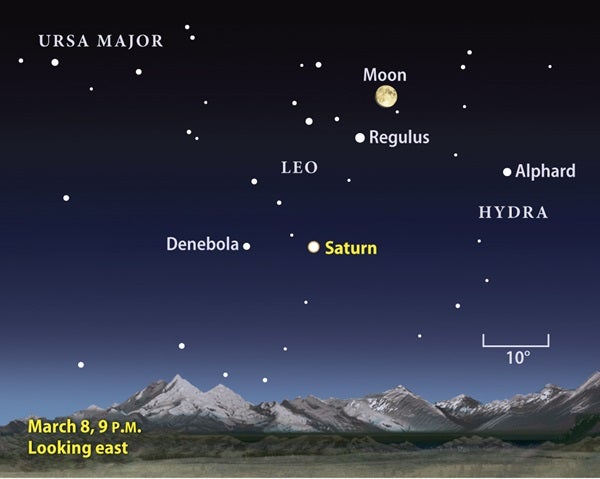Saturn reaches a point in its orbit called opposition March 8. At such times, the planet lies opposite the Sun from our perspective on Earth. This marks the best time of year to view the ringed planet because it lies closest to Earth and thus appears its biggest and brightest. At this opposition, Saturn will lie 780 million miles (1.26 billion kilometers) from Earth. Opposition is also when Saturn rises at sunset and sets at sunrise, so the planet remains visible all night.
Shortly after the Sun sets, look toward the east to see Saturn rising with the stars of Leo the Lion. Look 10° (the width of your fist held at arm’s length) southwest of Leo’s second-brightest star, Denebola. Later in the early evening, Denebola will lie to Saturn’s upper left.
Astronomy magazine Contributing Editor Mike Reynolds loves showing people Saturn. “Some people seeing it for the first time think it’s fake or a slide,” he says. “In reality, it’s one of the most amazing sights a telescope will reveal. And this year, with the rings nearly edge-on, will be a real opportunity for amateur astronomers to educate the public about how the planets move.”
Early evening is not the best time to turn your telescope on Saturn, however. That’s when the thickest part of Earth’s atmosphere will lie between you and the planet. Just 2 hours later, the planet lies one-third of the way up in a darker sky — a decent altitude for low-power viewing. For higher-magnification views (above 100x) or if you want to try photographing the planet through your telescope, wait until Saturn climbs at least halfway (45°) above the horizon, an altitude it achieves by 10 P.M. local time in mid-March.
The narrow ring-tilt provides observers with telescopes a good view of Saturn’s disk. Through a 4-inch scope, viewers will notice subtle shading, especially in the planet’s polar regions. The equatorial belts, now without the rings in the way, appear slightly darker than their surroundings.
Astronomy.com’s interactive star chart, StarDome, displays an accurate map of your sky. It’ll help you locate this spectacle.
Astronomy magazine subscribers have access to a slew of cool functions with StarDome PLUS.
Saturn images
See stunning images of Saturn in Astronomy magazine’s Online Reader Gallery. Submit your own images, too!











